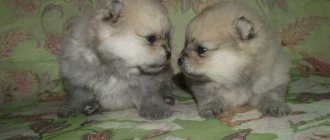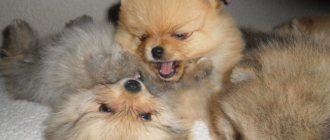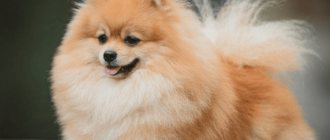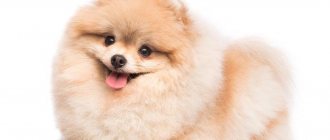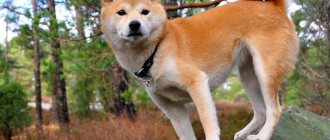Pomeranian puppies are adorable, furry creatures that can often be seen on TV or in photographs.
Small sizes, a touching muzzle and soft, fluffy fur, which makes babies of this breed look like soft toys, cannot but evoke a feeling of delight.
It is not surprising that many people, having only once seen such dogs in a photograph, rushed to get such a cute puppy as soon as possible.
However, before deciding to purchase such a pet, you need to carefully familiarize yourself with the features of choosing a Pomeranian and caring for it.
Do you know to what age Spitz grow?
More and more people are deciding to get a furry friend. The Spitz is an excellent companion and will definitely become a member of the family. However, a caring owner must closely monitor the puppy’s health and development, and this is impossible without knowledge of the main stages of a dog’s maturation.
One of the main factors that will determine whether a dog is healthy is its height. Consequently, both Spitz owners and simply fans of the breed should know what size dogs are at birth, how they grow, and what they need to pay attention to. Most owners regularly take measurements and weighings to monitor the correct development of the puppy.
Until how many months?
Dogs are fully formed by 2–3 years. This is the age when growth and development are completed and the puppy becomes an adult dog. In the process of growing up, the following main stages can be distinguished:
Until the first
Like the vast majority of puppies, Spitz dogs are tiny at birth; weight can vary from 50 to 130 grams. This represents only 5% of the mother's weight. The skin shows through the weak fluff; the puppies have a relatively large head and a short body with a thick belly. The body parts are still disproportionate, the puppy is completely helpless.
Be sure to keep an eye on the shades of your baby’s skin – bluishness is a reason to immediately contact a veterinarian, and may be a sign of serious health problems.
Puppies begin to see the light only two weeks after birth, and hearing appears only by the 17th–18th day. By the third week, there is no need for maternal assistance in bowel movements, and the puppy will begin to actively move only by the end of the first month.
Second third
With the beginning of the second month, Spitz dogs begin the process of teething. The puppy becomes capricious and has a constant desire to chew on something. During this period, it is worth purchasing special toys for your pet and putting away things that you want to keep. At this age, as a rule, the puppy is preparing to move to a new family. He has already laid the foundations for his future character.
By the age of three months, the puppy begins to shed its first coat, and the baby fur is replaced by adult hair. From this moment it is already possible to determine the future color of the dog. The ears begin to grow, and the muzzle begins to stretch out.
Fourth fifth
The main feature of this period is molting. The puppy is almost completely bald and has an extremely unpresentable appearance and is called a “squirrel”. This happens because the puppy loses its thick undercoat much more slowly than the main coat, which gives dogs a beautiful appearance.
The puppy's paws and muzzle are the first to lose hair. Then the body loses its characteristic shine and thickness.
This age is also characterized by intense tooth change.
Spitz quickly gain growth and acquire the proportions characteristic of adult dogs.
Sixth-seventh
Active growth and molting continues. By 8 months, a complete change of baby teeth usually occurs and they are replaced by molars. It is important not to forget to regularly examine your pet’s mouth - Spitz often have teeth with powerful, deep roots, which prevents them from being replaced in a timely manner.
If you find that the molar has already grown, but the baby tooth cannot fall out on its own, take your puppy to the dentist; you may have to resort to surgical removal of the interfering tooth. Untimely removal of baby teeth is fraught with changes in the bite and rotting of the tooth that did not fall out in time.
By 9 months, Spitz dogs usually reach show age. The fur coat is also already fully formed and has a presentable appearance.
1 year
For female Spitz dogs, this period is characterized by their first heat, however, it is too early to breed them. The last heavy molt takes place, the fur becomes more and more “adult”. The next fur updates will not be so large-scale.
At one year of age, dogs stop growing and begin to gain muscle mass.
2–3 years
By the age of two years, the sexual cycle of females is finally formed, from this moment they are ready to give birth to puppies. The dogs are fully formed, the body is harmoniously developed, in accordance with breed standards.
What do newborns look like and when do they open their eyes?
Newborn Pomeranian puppies don't look much like those fluffy babies in advertising pictures. They are born completely blind and deaf, with a body covered with rather sparse and very short hair.
Babies at this age look disproportionate and not nearly as attractive . Their head is large and slightly flattened, their body is elongated, their legs and tails are relatively short, and their bellies are voluminous.
Pomeranians begin to see the light approximately 10-15 days after they are born..
Deviations in puppy development
- First of all, the size of a dog is determined by genetics. If the animal's body weight is more or less than generally accepted, it is worth paying attention to its pedigree - most likely, you will find that one of the ancestors had the same characteristics as your puppy.
- The puppy's diet will also affect the growth and development. On natural food, a dog gains weight by 5–6 months, but on dry food, Spitz grow more slowly.
- Don't forget about vitamins - this is an important factor affecting the growth and development of a dog.
- Active walks contribute to the formation of a muscle corset. A puppy who runs a lot will become more athletic and grow taller.
Height and weight of adult dogs
To what age Spitz grow and how intensively their process of weight gain occurs depends on their species. It is generally accepted that a Spitz is a small dog intended purely for decorative purposes. But there are both miniature Spitz species and quite large ones with good guard qualities. The weight of a Spitz by month and the rate at which it gains depend on the type of dog.
This is interesting! Large Spitz dogs are often used by shepherds to guard sheep and other livestock.
Mini
Characteristics of mini Spitz:
- at the withers they reach 18-22 cm;
- body weight – no more than 3200 g;
- the coat is soft and very fluffy, hair length is medium;
- color – white, with a chocolate tint, sable, gray, black;
- life expectancy is about 10 years.
Mini Spitz are called dwarf, Pomeranian and miniature Spitz.
Small
Small Spitz dogs are somewhat larger in physical parameters than mini dogs, but they cannot be called large. Description:
- dogs can grow up to a maximum of 29 cm;
- weight – up to 10 kg;
- life expectancy – no more than 16 years;
- feature – wide, wedge-shaped head, medium-sized ears, high set;
- physique – fit, athletic;
- The coat is long and the undercoat is thick.
The colors of small Spitz dogs are the same as their mini-brothers.
Medium Spitz
Medium-sized Spitz have the following characteristics:
- they can grow up to 30-38 cm, boys are slightly taller and larger than girls;
- body weight – approximately 11 kg;
- life expectancy – up to 15 years;
- character – cheerful, active, inquisitive, education and training of dogs should begin from a very young age;
- physique – square, all parts of the body are proportional;
- the muzzle is round, large in size, the nose is dark, the eyes are almond-shaped;
- ears – medium, set high;
- the middle tail is ring-shaped;
- The color is predominantly monochromatic, although there are often inclusions of brown or red colors, as well as a combination of deep dark and light shades.
On a note! Medium-sized dogs are known as Mittelspitz.
Large
The largest representatives of Spitz are varieties such as Keeshonds and GrossSpitzes; they reach about 55 cm at the withers. Their weight is approximately 50 kg. They are used as shepherds. These are rare varieties of Spitz, they are extremely difficult to find in nurseries. Their life expectancy is 17-20 years.
Spitz can be very large, and in their appearance it is difficult to find similarities with all known ornamental animals
Deviations from the norm, reasons for non-compliance
Regardless of what type of Spitz we are talking about, they turn into adults by the age of 3 years. If an animal develops too slowly or, conversely, its parameters significantly exceed the recommended values for age, it is necessary to identify the cause. It can be associated with both severe pathologies and improper care of the pet:
- Slow development. The most likely reasons for a deviation from the norm to a lesser extent is a lack of vitamins and mineral elements in the pet’s food. Another factor influencing the weight of the animal is the use of small males or females for mating; they will give birth to equally small offspring.
- Indicators exceeding the norm are typical for dogs with an excellent appetite, fed a natural diet, and for pets that are highly active.
Note! You should not worry if, during the period of formation of the body, the dog slightly exceeds the norm in its physical parameters. If such a situation occurs in an adult dog, this may be due to two reasons, a genetic factor or obesity. If your pet is obese, you need to put your pet on a diet.
Obesity in Spitz dogs is common and dangerous.
Males and females
Is the maturation of males different from that of females? This is a pressing question for people choosing a furry friend for the family.
The main stages of development in Spitz males and females are absolutely the same. However, it is worth noting that by the end of the first year of life, females will have their first heat, and from this moment the dog’s sexual cycle will begin to form. Girls also shed a little longer.
Pomeranian, German and Japanese
The maturation of different Spitz breeds follows the same scenario. Regardless of the breed, a Spitz goes from a ball of fur to an adult dog in 3 years. They all grow quickly, reaching their final size by 5–7 months.
The owner should definitely take into account the following features of the formation of Spitz dogs:
- One litter may contain completely different puppies. The birth weight and skin color of the baby directly determine how the dog will grow up.
- If your pet has grown miniature, keep this in mind. Collars are not suitable for such puppies; they should also limit the ability to jump from heights - this can harm the dog.
- If a Spitz has outgrown generally accepted standards, come to terms with it; most likely, there were large ancestors in the pedigree, and it will not be possible to influence the size of the pet.
What to pay attention to
Every pet owner needs to know why it is so important to check the tables of normal physical parameters of the pet. Strong deviations upward or downward may indicate a number of pathologies, but this can be corrected with timely measures. Advice from veterinarians for owners of Spitz dogs whose pet sizes do not meet the standards:
- Dogs born in the same litter can vary significantly in weight. The body weight of an adult directly depends on what size it was at birth. If you want to have a miniature dog, you need to choose the smallest kitten from the litter.
- If a pet develops slowly and lags behind its peers, it may have problems with the musculoskeletal system, with bone and cartilage tissue that is too weak and prone to damage. He should not jump from heights, as this will most likely lead to serious injuries. It is necessary to add vitamin and mineral complexes to the diet that strengthen bone and cartilage tissue, and foods enriched with calcium.
- If a pet has larger parameters than allowed, but does not overeat, it is not obesity that is to blame, but genetics. Such large dogs will never be able to take part in exhibitions.
You need to contact a veterinarian if the Spitz at the withers does not reach 18 cm. In this case, there are accompanying symptoms such as bulging eyes, a thin bone corset, weak immunity, and weakness of the nervous system. Such pets develop slowly and require special care.
Important! You cannot ignore the situation when a Spitz gains weight due to overuse of treats. Obesity has an extremely negative impact on a Pomeranian's health and can significantly shorten its life expectancy.
Owners of Spitz dogs must take into account the data indicated in the scale of the pet’s physical parameters. You should not be lazy in measuring your pet at different stages of growth. Deviations from the norm to a greater or lesser extent require finding out the reasons and taking timely measures. Too little or too much weight can lead to a number of health problems. Small deviations are acceptable and are associated, for the most part, with genetic predisposition.
German Spitz - description of the breed
There are several types of such pets:
The listed types differ in size. The small German Spitz grows up to 29 cm, the dwarf Spitz - up to 22 cm. Other characteristics are similar for all varieties. The dogs have a square body and a large fluffy tail that fits tightly to the back. The Spitz has a medium-sized head, and the muzzle tapers towards the nose. Its lobe is colored brown or black.
The German Spitz breed has a double undercoat. The shortest hair is on the ears and face. Standard colors of the breed: gray, white, brown, tan. The fur color of animals can change during puppyhood, but by the age of three it acquires permanent shades. The German Spitz is also called the Pomeranian. However, in the USA, Canada and England these breeds are considered different.
What does a German Spitz look like?
The breed must meet a number of standards. This does not depend on what kind of dog you are considering - red, black or white German Spitz. Main external characteristics:
- head – wedge-shaped;
- nose - round, dark in color;
- bite – pincer-shaped with 42 teeth;
- eyes – almond-shaped, medium size;
- neck – moderately long, has a bend at the nape;
- ears – closely spaced triangular;
- tail - in the form of a single ring;
- legs are muscular, straight.
How to choose?
When purchasing a pet, you need to treat it as responsibly as possible: study the basic requirements of the standard, conditions of keeping and feeding.
Also, even before purchasing a puppy, you need to purchase what you will need to care for it: toys, shampoos, a bed, a bowl, a tray, etc..
In order to avoid unpleasant surprises associated with purchasing a mongrel puppy instead of a Pomeranian or problems with the pet’s health, it is recommended to contact a club or kennel.
At the same time, you need to formulate your wishes regarding the puppy as precisely as possible: you need a show dog or a dog for breeding, or maybe just a pet.
Based on this, the breeder will be able to select the most suitable puppy for the buyer..
Before buying a baby, the future owner needs to check whether its exterior meets the breed standard, and also make sure that the puppy is healthy.
A small Pomeranian should have a compact, almost square body, strong, thick paws, a muzzle that is not too long, but not too short, and a fairly convex skull..
His back is not sagging, and his stomach is only moderately retracted. In this case, the puppy should look quite dense and well-fed, with clean eyes, ears and skin.
The color of the baby may differ from the color of the coat that he will have after growing up.
For example, red dogs are born brown and only gradually acquire an orange tint to their coat.
However, black , white and brown Pomeranians should look as uniform in color as possible, since even the slightest extraneous tint is not allowed in these colors .
German Spitz - character traits
Dogs are highly trainable and can get along well with both adults and children, but if left untrained, the pet can become uncontrollable. The Small and German Dwarf Spitz especially love attention, so they always try to be near their owners. Dogs choose one person to whom they are infinitely loyal. He must train the animal.
The positive traits of the breed include patience. Pets tolerate long trips in transport well and can wait for the owner on the side during a walk. Spitz dogs are good with small children, who do not always handle their pets carefully. They get along without problems with other animals in the house because they have a friendly disposition. If necessary, German Spitz dogs come to the defense of the owner and his property, showing all their protective qualities.
Adult American Eskimo Spitz
A distinctive feature of the “Eskimo” is a distrustful attitude towards strangers, therefore, if the owner wants to raise a dog that makes good contact, the animal should be socialized as early as possible. A photo of an adult Spitz is presented below.
The American Eskimo Spitz, like its other brothers, is active and charismatic. A dog can serve a person both as a watchdog, on a hunt, and simply as a four-legged friend.
The size of an adult American Eskimo varies from 22 to 49 cm at the withers. The dog weighs from 8 to 16 kg.
How old do German Spitz dogs grow?
The development of representatives of this breed does not take much time, so by 5-6 months. the animal grows to its final size. As for the lifespan of a pet, the larger the dog, the longer it is, so the question of how long German Spitz live cannot be answered unambiguously.
German Spitz - pros and cons
The peaceful nature and pretty appearance make the breed a favorite among numerous breeders. They are attracted by the fact that dogs willingly get along with different pets, even cats. Small and medium-sized German Spitz are able to live for a long time in an apartment in cramped conditions. Other advantages of the breed include:
- the possibility of accustoming to a diaper, which is especially important if the owner does not have enough time to walk the pet daily;
- no habit of chewing shoes or furniture;
- possibility of universal movement with the owner: Spitz dogs are placed in backpacks and bags;
- unpretentiousness in care and nutrition.
The breed also has disadvantages that you need to familiarize yourself with before getting a dog. During a walk, a German Spitz can become distracted and run away from its owner. During the shedding period, your pet's fur requires regular brushing. Otherwise, the pet's fur will accumulate on clothes and interior items. Another significant disadvantage of German Spitz dogs is their high cost. How much a German Spitz costs depends on its color and pedigree. The average price for puppies ranges from $400 to $500.
What size and color will an adult Spitz be? What does the size depend on?
I always advise you to go to the original source, i.e. to the breed standard. In the breed standard you will read reliable information about the correct name of the breed, sizes, colors. It is almost impossible to predict the size of a dog until a certain age. An exception may be extremely small puppies from birth. Usually by the age of 6-7 months it is possible to speak with a high probability of the size of an adult Spitz. I consider the age of 2-3 months not indicative for determining the size of a puppy. A puppy can be large from two miniature parents and small from a large mother. This is due to the fact that inter-height matings are allowed in Russia, i.e. mating between two different growth varieties of German Spitz. Plus complex genetic networks. Since small size is an artificially fixed sign of a miniature Spitz, the size of not only the parents, but also more distant relatives along the pedigree should be taken into account.
Relying on the puppy's weight is also often pointless. Because there is a significant difference in the weight of a Pomeranian and a German Spitz. Pom (short for Pomeranian), the American type of German Spitz is a heavy-boned dog, while the classic German Spitz is a lighter-boned dog. Therefore, the difference in weight is significant for two individuals of the same size, but not weight. The Pom is heavier than the German Spitz due to its heavy frame. This is a busier dog than the German Spitz.
Is it possible to buy a white, black, brown, party-colored Spitz from the Starpom kennel?
No. Our nursery has only orange breeders (including red, red sable, orange sable). Breeding only pure orange dogs is one of the rules of my kennel.
Why is the puppy's color gray? Can you trust if they promise that a gray puppy will grow into an orange Pomeranian?
The color of a Pomeranian puppy can be gray and gray with black hair and pure orange. As a result, a dog will grow up with the same orange color. Gray puppy color is a normal color. For greater reliability, you can look at the parents plus look at the pedigrees of the dogs. Plus, again, read the breed standard, where you will not find a gray, smoky color in a Spitz. The puppy's gray hair quickly changes to bright orange and red.
What kind of care does a Pomeranian or German Spitz require?
Being a fluffy dog, the German Miniature Spitz requires constant coat care: i.e. Regular brushing of the dog, trimming the nails, caring for the paws, eyes and of course washing the dog. Nowadays the dog cosmetics market offers a huge number of all kinds of products to keep your Pomeranian in perfect condition. I will not list all kinds of brands and brands. I will only say that the dog needs to be washed with shampoo and rinsed with conditioner. For combing, have a “slicker brush” and use it while the dog is shedding. You should also have a “claw clipper,” a metal comb for everyday brushing. When brushing your Miniature Pomeranian, I suggest using a detangling or anti-tangle conditioner. Always use conditioner when brushing your dog! After bathing, the puppy's coat needs to be dried with a hairdryer and combed.
After 5 months, you should monitor your bite and baby teeth more carefully. Around this time, the replacement of baby teeth with molars begins. It is impossible to say with absolute certainty whether teeth will change at 4 or 6 months; this is all individual, just like the fact that some Pomeranian puppies require the help of a veterinary dentist to remove their baby teeth.
Is it necessary to walk a dwarf Spitz?
This question is clear to me. Yes. Necessarily. No matter the size of your Pomeranian, walking is a must for owning a dog! Your Pomeranian may be trained to relieve itself at home in a litter box, but walking is key to your dog's physical and mental health! You should definitely take your dog for walks; this is necessary for the development of any animal. Of course, a dog can grow up on its own, but it is difficult to imagine that it will have the manners and social behavior that a person expects from it. For walks with your Spitz, I recommend a harness and tape measure. Don't worry, the harness won't dry out the luxurious fur during a short walk. But it will be much more reliable than a collar, from which it is very easy to break out. For a Spitz, a 3-meter tape measure is quite enough for active walks as well.
About the Show again
A question that remains eternal for a huge number of Pomeranian puppy buyers. What quality is the puppy: “SHOW”, “BRID” and “PET” class. The future owner of a puppy needs to understand before purchasing what kind of puppy he needs and for what purpose he is purchasing the puppy - as a pet or for breeding. And this is not a stupid desire of the breeder. Not all purebred dogs are suitable for breeding or for showing. Only the most worthy and healthy dogs that best meet the breed standard should be bred. The puppies are promising, i.e. SHOW class meets the breed standard and does not have disqualifying defects or major flaws at the time of sale. With proper raising and care of the puppy, the owner has every chance to raise a worthy representative of the breed, participate in dog shows, and with excellent training of the dog, receive high marks, as well as be in demand by the manufacturer. The price for a promising puppy is always quite high, regardless of the gender of the dog being sold. BRID class puppies - the puppy has no disqualifying defects, but there are deficiencies that may affect his successful career. If the future owner is not interested in showing and breeding your Pomeranian, you should pay attention to a pet-class puppy. A puppy in this category also has documents, he is also a purebred puppy, but in some respects he is not suitable for breeding and showing. These are disqualifying defects at the time of sale of the puppy and personal characteristics, for example, the puppy does not have the character of a show dog - an insecure puppy. Disqualifying defects do not pose any threat to the life and health of the puppy and do not in any way affect the quality of life. He will be the same great friend and favorite of the whole family. The cost of this category is lower than that of a show dog. The quality of the puppy will determine both the price of the puppy and its future life. That is why when buying a dog you need to clearly know your desires and not forget about your capabilities after weighing the pros and cons. Until about 8-9 months, the quality of the puppy is determined approximately and a transition from one class to another is quite possible after the puppy grows up. 03/28/2017
How active and restless are Spitz puppies?
Young animals, puppies, are more energetic than adult Pomeranians. This pattern continues until the Spitz puppies reach social maturity (18-36 months). However, the characteristics of the breed are such that the Pomeranian maintains a playful character and cheerful disposition throughout his life, being an active participant in all games. If you want to bring joy to your pet, buy him special dog toys at pet stores. Spitz loves toys that can squeak.
Keeping your Pomeranian safe.
To ensure your Pomeranian lives a long and happy life, every owner must keep their pet's safety in mind throughout its life. If you live in an apartment and walk your Pomeranian in the city, be sure to walk your dog on a collar, harness, or leash. This way you will prevent a lot of troubles, such as encounters with large dogs, cars, bicycles, etc. Don't be afraid to damage your Spitz's coat with a harness or collar. During a walk, it is impossible to wipe the fur down to the skin. When you get home, take off your walking gear until next time. For Pomeranians I recommend a 3 meter tape measure, for a Small Spitz - 5 meters. In the absence of the owner and interesting toys, the house turns into an amusement park, where the Spitz is looking for something to do. And sometimes this can end not only in material waste. Protect your pet from contact with electrical appliances. Remove from the dog's visibility and accessibility all electrical cords that are plugged into sockets and pose a real threat to your pet's life. Electrical appliances are one of the most dangerous items in the home. If there are small children in the house, take care to protect the puppy from contact with children's toys, as they can also be dangerous for a curious Spitz. A dog, and even more so a puppy, can easily swallow small parts during play, which can lead to surgery on the esophagus or stomach at best. Do not leave other potentially dangerous objects unattended on surfaces accessible to your Pomeranian. Make your pet's stay in the house comfortable for all residents. 08.12.2016.
Toys and treats.
The Pomeranian Spitz is an active and cheerful dog, which is probably why these dogs are ready to play with toys from early childhood to old age. For this reason, take the choice of toys very seriously, despite the fact that we are talking about games. It is better to purchase toys for dogs and puppies in pet stores. Toys for children often contain parts that a dog can chew off and swallow, which can lead to surgical intervention. I recommend stuffed animals with squeaks. The Pomeranian will quickly understand how to extract sound from such a toy and can play with it for a long time. For outdoor games, of course, choose balls; your Spitz will quickly master the command to bring you a ball, and walking with your pet will bring pleasure to both the dog and the owner. Do not buy balls that are too large or, conversely, too small. When choosing a ball, you need to understand its size so that the Spitz can easily take the ball into its mouth without swallowing it. It can also be squeaky, which will make it even more interesting for your pet. For games at home, in addition to soft toys, you can use plastic ones, for example, bones with the addition of bone meal. Such treats are very attractive, they have a natural aroma, perceptible only to the dog, and a natural taste. At the same time, the owner is sure that the Spitz will not be poisoned, will not bite off a piece and will not choke. Thus, the dog toy market is very diverse and interesting. Choose the right toys and you will have peace of mind, a whole house and a busy dog. 08.12.2016.
What to feed your Pomeranian Spitz?
Nowadays, when everyone is very busy at work, the best feeding option is ready-made food. To feed your Pomeranian, choose the best - Super, Premium food. I don't see the need to combine dry and wet food. The main thing is the highest quality product. What kind of flavor it will be - fish, lamb, beef, rabbit, turkey or chicken - choose for yourself based on the preferences of your Pomeranian. Lamb is generally considered hypoallergenic, fish foods are grain-free (potatoes replace them), chicken is traditionally suitable for all ages, and is enjoyed by puppies to adult dogs. It must be remembered that when keeping a dog on dry food, be sure to ensure sufficient water consumption, which should always be fresh, clean and easily accessible. The amount of protein and fat is normal. For a Spitz, 21-26% protein and 12-16% fat are sufficient. This is optimal. If your dog has certain problems, you need to consult a doctor and choose a veterinary diet. In case of acute and chronic disease, the diet is prescribed in the first case for about a month, in the second, lifelong consumption of a veterinary diet is possible (for example, in case of renal failure). 06/29/2019.
I feed my dogs dry food. But like any person, I can’t resist giving the dogs a treat. Yes, I give dogs meat, cottage cheese, eggs. My dogs also get some vegetables and fruits as treats. The little Spitz eats 4 times a day, then, by 9 months, we gradually reduce the feeding frequency to 2 times a day. All these dates are individual and approximate. The food itself is also distinctive. Puppies require special food, higher in calories, which is necessary during the period of intensive growth.
Is it possible to cut a Pomeranian's hair short?
Recently, there has been a fashion for short haircuts for Pomeranians. This is due to the fact that many photos of a Pomeranian named Boo have appeared on social networks. The owner of this Spitz gives her pet a clipper cut and was able to make him a star, primarily due to her creative ideas. Unfortunately, this turned out to be a blow for Spitz dogs in general. Dog grooming has begun, and this causes enormous harm to the condition of the dog's coat. The Spitz's coat is such that it does not require a drastic haircut. And cutting a haircut with a clipper or extremely short changes the structure of the hair. And then, after a haircut, getting a fluffy, beautiful dog again becomes not only problematic, but practically impossible. The structure of the hair changes, becomes wadded, becomes tangled and very difficult to care for. This occurs because the awn, which by nature serves as protection for the undercoat, is removed and the undercoat, soft and fluffy, remains unprotected. The axis grows more slowly and thus the dog changes color and the hair structure deteriorates, which takes years to restore. This statement is more correct for Pomeranian Spitz males since females change their hormonal levels 2 times a year and estrus also occurs, which contributes to a rapid change of coat. So females recover faster after cutting than males.
I generally do not recommend such haircuts to my clients.
Pomeranian Boo looks impressive primarily due to his type of real Pomeranian, very beautiful head, expressive eyes and bright personality.
Do Spitz dogs need vitamins and nutritional supplements?
If you feed your German Spitz super premium dry food, your dog will not need any additional vitamins. If your dog receives natural food, you must add vitamins to its diet. There are also nutritional supplements used at different periods of the life of the Pomeranian Spitz - in childhood, for the formation of the skeleton, teeth, during molting, for coat, during physical activity, for joints, and much more. other.
From about 4 months we introduce vitamins with calcium into the diet for a month to a month and a half. From 6 to 7 months we change vitamins to preparations with glucosamine and chondroitin. We give the supplement for about 2-3 months. By the age of one year, we change the drug to vitamins for fur and give the same to the dog for about a month. For an adult dog, I would keep the skin and coat vitamins and multivitamins.
For older Pomeranians, medications with glucosamine and chondroitin to maintain healthy joints are more relevant, plus medications for individual indications, as well as medicinal foods that may likely be needed.
How to toilet train a puppy?
Some recommendations that will help you, with your desire and persistence, to train your dog to the toilet. Firstly, do not forget that you will need patience and regular, methodical observation of the puppy. Know that your time will not be wasted. And if you are a good teacher you will complete this task in a week, if you cannot train the dog regularly or cannot convey your wishes to the dog, you may spend more time than a week, but you have years of life ahead of you, so approach the task persevere and don’t give up your achieved successes halfway. To begin with, it must be said that a dog remains a puppy for up to 9 months and it is quite stupid to demand from a two-month-old puppy to fully perform his duties in the tray. Next, it should be noted that puppies often grow up in playpens, where they actually wear a diaper and newspaper. A small space quickly orients the puppy where the toilet is, where the resting place is and where the food bowl is. Remember, Spitz, like all animals, are clean from birth! Don't forget about this when training to a tray or place. The main thing is that the dog understands WHAT YOU WANT. And she will do everything just out of love for you, because she loves you and doesn’t want to upset you in any way! To begin with, when picking up a puppy from its parent’s house, find out what the puppy was accustomed to - diapers or newspapers, or walked outside. Use the same material at home. At least for the first time. • Take the puppy out more often, immediately after sleeping, eating, playing, or walking. • Allow your puppy to sniff his litter box. • Praise the puppy as soon as he sits down, possibly giving him a treat. • Don't physically punish your puppy! This can cause fear and the puppy will begin to relieve itself, avoiding open places where the tray is located (for example, behind a curtain so that the owner does not see - after all, the puppy has been punished). • Be consistent and persistent. • Be patient. Remember that we also teach a small child useful skills and develop useful habits in our children. • Choose a place for the toilet so that it is accessible to the dog 24 hours a day. • Try to distract the Pomeranian Spitz when he crouched in the wrong place, without needing to frighten or scold him. You just need to attract attention - you don’t need to knock or shout, you can just say “oh” loudly so that the puppy is distracted from his business. • At first, you can have several places for a toilet at home. The first stage of consolidating going to the toilet is. The number of diapers can then be reduced to the required amount. • Remember, locking your Pomeranian in a playpen is not a solution to the situation. A dog is a social creature, it needs you and will be very unhappy if its life is spent in a playpen. Keeping a Spitz in a playpen leads to the dog mistaking it for his home and his apartment for the street. This is absolutely normal for a small dog. Thus, she will tolerate and not go to the toilet in the playpen (this is a house, after all) and will begin to perceive the apartment as a place for walking. Once again, don't scold your dog! Leave silently, without commenting on her misconduct. I want to tell you about an incident that happened to my puppy in a new home. The new owner of my puppy described his dog’s behavior as unclean, only at home and behind the sofa or curtain. They walk the dog, but she doesn’t do anything outside, and when she comes home she relieves herself, hiding behind the sofa. During the conversation, it turned out that the owner was punishing the dog for unclean behavior at home. What happened? The dog understood only one thing - they scold her when they see that she goes to the toilet. She cannot understand that she is being scolded only for doing her business in the house, but she knows one thing - the owner is unhappy that she is getting dirty. During a walk, the owner is nearby, and she does nothing with him. Thus, when walking, again, remembering the punishment, she endures. And hides in the house so as not to be punished. This example very eloquently shows how important it is to correctly formulate your desires so that they are understandable to the animal!
What documents should a puppy have? Why don't they give me my pedigree right away?
When purchasing a puppy, you must be given a veterinary passport with vaccination records. Also, if the puppy’s parents are registered in the RKF, you must be provided with a puppy card issued by a club or kennel, which the puppy’s owner can exchange for a pedigree. The exchange is carried out at the RKF (Russian Cynological Federation). A sample puppy card can be seen on the official website of the RKF. To avoid troubles when buying a puppy. A pedigree is a document confirming the origin of a dog. The document itself is a laminated sheet of A4 format. Since the document is laminated, it is not possible to enter the owner, so puppies are sold using puppy cards and subsequently exchanged for pedigrees.
Traveling with a Pomeranian Spitz together.
From time to time, almost everyone needs to travel (vacation, business trip, etc.) with a dog. Therefore, questions and concerns about this are quite understandable. In my opinion, the first and most important issue is purchasing a ticket. When purchasing a ticket, if you are traveling by public transport, you must declare your pet. If you are traveling by train, choose a carriage that allows your Pomeranian. If you are traveling by air, when purchasing your air ticket, contact the airline and request that your dog travel with you. Over the phone, the airline representative must give you permission to carry your dog. ONLY after receiving permission you can safely buy a ticket. You must strictly comply with all airline requirements (carrying size, weight), otherwise you may be denied boarding already at the airport, during check-in. Once permission to transport a dog has been received, the following steps must be taken. Buy a carrier (dog bag) that fully meets the requirements of the carrier. When flying within Russia, veterinary certificates are canceled; you must have a veterinary passport with vaccination records in the proper amount according to the age of the Spitz. We issue certificates only for trips outside Russia. Certificates are issued by state veterinary stations, if the dog has a veterinary passport with vaccinations and full quarantine (this is a requirement for puppies. From the date of rabies vaccination - 21 days, for Europe, other countries - 30 days from the date of vaccination). The dog must also have a chip. So you're almost ready to go. You have purchased tickets, a carrying bag, you have all the documents: a veterinary certificate and a veterinary passport. Don't forget to bring food with you. After all, it may well happen that there is no food in your new place and you have no time to look for it. For the trip, stock up on the required number of disposable diapers and napkins. Don't forget a water bowl. I hope that you took everything with you and then your trip will be easy and not tiring. 06/29/2019.
How much does a Pomeranian cost?
Perhaps this is the first and sometimes only question that I hear more often than others. To the great chagrin of many, I cannot answer this question unequivocally; there are many factors that influence the price of a Pomeranian. The main factor is breed!!! Yes, exactly the breed. So, it is impossible to buy a purebred puppy with documents absolutely cheap. Even a Pomeranian with a deficiency can be expensive. If the dog is a pet, the price is lower; if a dog has no flaws, the cost increases. But here everything is not so simple. There are Pomeranian Spitz from which you cannot buy puppies on the open market, or you have to wait a very long time, such dogs are very expensive and puppies from these producers will not be cheap. And there are Pomeranian Spitz dogs that have no value in breed circles. And despite the fact that the puppy has no flaws, it is sold quite cheaply. Other factors are the presence of exterior characteristics of the puppy and the absence of disqualifying defects. Up to 2 months of age, a puppy may not have these factors. This is why I do not evaluate puppies under 2 months and do not put them up for sale. In kennels with dogs of interesting “blood”, puppies always have a high price, because often these puppies will grow up and form the breeding base in other kennels. Our nursery's Spitz dogs have a high price. The high rating of our dogs can be easily seen from the fact that more than 70% of our graduates are purchased by other kennels. You can see puppies with the Starpom prefix in the nurseries: • "Game Time" - Kaluga - ("Starpom Mitra") • "Luxori Pom" - Nalchik - ("Starpom Luxori") • "Darikar" - Kharkov - ("Starpom Deep Emoushin" ", "Starpom Zest Selekshin") • "Pomfavorit" - Bulgaria - ("Starpom Candy") • "Damerino" - Kazan - ("Starpom Morris") • "Malpom" - Moscow - ("Starpom Roxalana") • "Altironenex" " - Vladimir - ("Starpom Willie") • "Oroslando" - Kaluga - ("Starpom Ariadne") • "Leoria Life" - Kirov - ("Starpom Lucky Beti") • "Natalie Lux" - Tver - ("Starpom Harry ) • “Angel of Eden” - Israel - (“Starpom Charlik”) • ..... The quality of my dogs is time-tested. However, if we talk specifically about the cost of puppies in my kennel, then it is higher than the price tags that are plastered in large numbers on popular message boards. 02/10/2017
Why do they use different names for the same breed?
Yes indeed. We are constantly faced with the fact that we hear either a Pomeranian Spitz, or a German Spitz, or a dwarf Spitz. Which name is correct? Since July 18, 2012, Pomeranian and Miniature Spitz have been officially adopted by the RKF as the names of the German miniature Spitz.
Transition period from Pomeranian puppy to adult dog
In the life of every Pomeranian puppy there is a period of unprepossessing Spitz - from approximately 4 to 9 months of age. Photos of Spitz dogs of this age category are rare on the Internet and here’s why... read more
What you need to know before buying a Pomeranian
Recommendations for choosing a puppy are placed on a separate page.
Which is better - Pomeranian or German Spitz?
The answer to this question depends on the purpose for which the breeder purchases the pet. The German Spitz has a calmer character and is better able to demonstrate protective properties. For this reason, they are suitable for people with limited mobility and the elderly. The animal is also recommended for those breeders who can devote time to training the animal.
The German mini Spitz is more reminiscent of the Pomeranian in terms of its character. They are very active and prefer to lead an active lifestyle. For this reason, the Pomeranian is more suitable for young families or breeders who have children or pets. They easily find a common language with other living beings. It is impossible to clearly choose which breed is better; it increasingly depends on personal preferences.
What vaccinations does a puppy need?
While breastfeeding babies, passive immunity protects them from infections. With the transition to self-feeding, its effect weakens, so vaccination begins at 8 weeks.
Veterinarians offer a schedule of basic vaccinations, which includes the administration of complex drugs against major infections (hepatitis, leptospirosis, enteritis, distemper, parainfluenza). Combined vaccination of Pomeranian Spitz is carried out at the age of:
- 8-9 weeks;
- 6 months;
- 1 year.
At 12 weeks, in addition to the comprehensive vaccine, the puppy is given an anti-rabies drug.
Would you like to get yourself a Pomeranian?
German Spitz - care and maintenance
There is nothing difficult about keeping the breed. Dogs' fur does not require regular grooming because it is capable of self-cleaning. It is necessary to comb the animal during periods of shedding. If after a walk the dog’s coat becomes wet and dirty, then you should not bathe the Spitz. You need to let the wool dry and then remove dirt from it with a brush. The German Miniature Spitz should walk in overalls during the cold season.
There are other nuances of caring for the breed. They include:
- organization of diet;
- fur trimming;
- shortening of claws;
- walking
What to feed your German Spitz?
Pets do not have problems with the gastrointestinal tract, but they have a tendency to be overweight. Because of this, Spitz dogs are fed only natural food or professional dry mixtures: Gemon, Dog Show, Hills. Mixing both types of food is prohibited, as this increases the load on the pet’s liver and stomach. Most of the German Spitz's menu should consist of lean meat or poultry. In small quantities, they can be given offal and boiled fish, previously cleaned of bones.
List of what you should not feed your German Spitz:
- chicken bones;
- spicy, fried and fatty meat;
- confectionery;
- pickles.
Puppies up to 2-3 months. fed 5-6 times a day. As you grow older, the frequency of meals is reduced and the portion consumed is increased. By the first year of life, the pet is transferred to an adult diet - twice a day. At the same time, the required amount of food should be clearly measured so that the German domestic Spitz does not overeat. A small dog easily eats more than it should because it does not feel full.
What to feed for the first 3 months?
From about the third week, puppies can already begin to be fed solid food . It is most convenient to start complementary feeding with a scraper.
To do this, take a piece of muscle meat and run the edge of a spoon along its side several times. Small balls, slightly larger than a pea, are made from the scraped meat, and one piece is fed to each of the babies.
Some breeders replace scraped meat with minced meat, but this is incorrect, since minced meat is less easily absorbed by the puppy’s body..
Later, babies begin to be introduced to other foods: cottage cheese mixed with kefir or natural yogurt, as well as porridge added to meat and vegetables.
In addition to beef, small Pomeranians can also be fed rabbit meat, turkey or lamb . But it’s too early to give offal at this age.
Then, it will be possible to add boiled sea fish without bones to the diet, and give boiled chicken yolk twice a week.
IMPORTANT!
If you decide to feed the puppies with ready-made food, then this should be done from the very beginning, after the kids try scraped meat for the first time.
In this case, their diet will consist of branded food no lower than super-premium class, which should be soaked in warm water in the first three months of the puppy’s life.
You can also feed puppies wet commercial food that is suitable for their size and age..
Muzzle for German Spitz
Finding the right accessory for your pet is not easy. They need to be purchased if the German Spitz is large. For small individuals of the breed in question, a muzzle is not used. The exception is when a mini Spitz throws itself at the feet of others or picks up trash from the floor. In this case, an accessory is ordered for him in individual sizes. Muzzles for Spitz dogs are made from genuine leather or nylon materials.
Size of different types of adult oranges
Mini
The mini-Spitz is the tiniest representative of the Pomeranian breed (it is also called dwarf or miniature Spitz). These fluffies look more like a plush toy than a real dog. The height of a mini Pomeranian Spitz at the withers is from 18 to 22 centimeters, and such a baby weighs no more than 3 kilograms. The maximum weight of a dwarf Spitz is 3.2 kilograms.
The size of dwarf spitz puppies is even smaller.
Small
These representatives of the Pomeranian breed are larger than the previous ones. Such dogs grow to a maximum of 27-29 centimeters, and their body weight is within ten kilograms.
Average
The average representatives of the breed are called Middle Spitz. These four-legged animals reach from 30 to 38 centimeters at the withers, and already weigh around 11 kilograms.
Large
And these are truly large Pomeranians, reaching a height of 55 centimeters. Their body weight often reaches 25-30 kilograms. Large representatives of the Pomeranian breed are called Wolfspitz and Keeshund. These are herding dogs that always have a uniform coat color. Large Wolfspitz puppies sometimes weigh 5 kg.
German Spitz training
Thanks to their keen mind, representatives of the breed in question can easily carry out all the commands of the owner. The breeder must wean the dog from barking loudly for no reason and begging for food. Without training, your German Spitz puppy will become capricious and uncontrollable. Another important point in raising a pet is training it to use the tray. Before buying a puppy, you need to ask the seller what he is accustomed to: newspaper, diaper or outdoors. At first, you need to organize the same toilet for the animal.
Training begins at 5 months of age. First, Spitz dogs are taught to respond to a name. Another important command that a dog must know is place. To do this, after feeding, the puppy is taken to the mat and this word is said. Next, the Spitz is taught other necessary commands: to me, next to me. They are needed to keep your pet safe. The last command that the dog must be taught is fu.
Diseases of the German Spitz
With proper care, the average life expectancy of pets is 14-15 years. They are distinguished by good health, but there are a number of diseases to which German Spitz puppies are susceptible:
- dental pathologies – malocclusion, stone formation on the enamel;
- diseases of the musculoskeletal system - fractures, bruises and subluxations;
- dysfunction of the digestive system - dysbiosis, obesity;
- eye diseases - lacrimation.
Why do my German Spitz's eyes water?
In healthy dogs, minor tearing is allowed. The red German Spitz has a genetic predisposition to the problem. You should consult a doctor if copious amounts of pus are discharged from your eyes. Main causes of the problem:
- ingress of dust and dirt onto mucous membranes;
- allergic reactions;
- serious infectious diseases in the body;
- improperly growing hair around the eyes;
- injury to mucous membranes;
- unbalanced diet.
Mating a German Spitz - rules
The optimal age for mating is 12-36 months. It is important that before mating the dogs are treated for parasites and have exhibition achievements corresponding to the breed of dog - German Spitz. Basic mating rules that breeders should know:
- the first meeting is supplemented by the second and third with an interval of 24 hours;
- mating is organized on neutral territory or in the house where the male lives;
- dogs occur only during the period of estrus in females, which occurs 2 times a year and lasts on average 21-28 days.
Source
